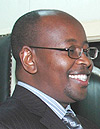• Expenditure likely to increase by 10 percent The Finance Minister will present the 2009/2010 budget to parliament today, aligning it with the rest of EAC member countries whose financial year runs from July to June.


• Expenditure likely to increase by 10 percent
The Finance Minister will present the 2009/2010 budget to parliament today, aligning it with the rest of EAC member countries whose financial year runs from July to June.
Kenya, Uganda and Tanzania will also be reading out their budgets today.
In this year’s budget, expenditure is projected to increase by 9.5 percent to Rwf812.4 billion from Rwf742.7 billion spent in the last financial year.
Though government’s goal is to dramatically scale down aid dependency in the near future, this year’s budget is almost evenly financed by both internal revenues and external grants and loans.
Projections obtained by The New Times indicate that domestic revenues will account for almost 49 percent while remaining percentage is donor money. Internal resources are projected to increase by almost 9.3 percent to Rwf393.7 billion from Rwf359.9 billion collected in the ending financial year.
On the other hand external resources will increase to Rwf418.7 billion from Rwf382.78 billion though the biggest percentage will be grants.
The draft budget proposal seen by The New Times has grouped this coming year’s financial spending into four clusters; infrastructure, productive sector, human development and social sector as well as the governance and sovereignty cluster.
If no significant changes are made to the draft budget proposal, then governance and sovereignty cluster will take the lion’s share of the budget consuming Rwf299.2 billion or 36.8 percent of the entire budget.
Though the current budget draft does not propose any new taxes, Finance Minister James Musoni is likely to announce structural changes in the tax regime, especially to mitigate losses that will result from Rwanda joining the EAC customs union.
MPs last month requested government to increase the total budget by an extra Rwf14 billion for the productive cluster.
Ends


